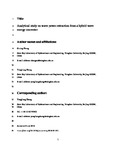Analytical study on wave power extraction from a hybrid wave energy converter
| dc.contributor.author | Zheng, Siming | |
| dc.contributor.author | Zhang, Y | |
| dc.date.accessioned | 2018-08-12T10:37:31Z | |
| dc.date.issued | 2018-10-01 | |
| dc.identifier.issn | 0029-8018 | |
| dc.identifier.uri | http://hdl.handle.net/10026.1/12010 | |
| dc.description.abstract |
In this paper, a hybrid wave energy converter (WEC) is proposed, consisting of a fixed inverted flume with long length and a bottom hole, and a long floating cube hinged with the flume. The inverted flume and the long floating cube works as an oscillating water column (OWC) and a rotational float, respectively, to capture power from incident waves. To study the performance of this hybrid WEC, analytical solution of the wave diffraction/radiation problems, considering the hydrodynamic interaction between the OWC and the float, is derived based on linear potential flow theory and eigen-function expansion matching method in the two-dimensional Cartesian coordinate systems. The corresponding hydrodynamic coefficients, such as wave excitation forces, added mass and wave radiation damping, are also obtained, which can be further used in evaluation of the maximum theoretical power absorption of the hybrid WEC. Results are compared with a parallel study of an isolated OWC and an isolated float. Additionally, analytical study on power capture capability of the device for various geometrical parameters is then carried out. | |
| dc.format.extent | 252-263 | |
| dc.language | en | |
| dc.language.iso | en | |
| dc.publisher | Elsevier | |
| dc.subject | Linear potential flow theory | |
| dc.subject | Analytical model | |
| dc.subject | Wave power extraction | |
| dc.subject | Oscillating water column | |
| dc.subject | Hinged float | |
| dc.title | Analytical study on wave power extraction from a hybrid wave energy converter | |
| dc.type | journal-article | |
| dc.type | Journal Article | |
| plymouth.author-url | https://www.webofscience.com/api/gateway?GWVersion=2&SrcApp=PARTNER_APP&SrcAuth=LinksAMR&KeyUT=WOS:000446287400020&DestLinkType=FullRecord&DestApp=ALL_WOS&UsrCustomerID=11bb513d99f797142bcfeffcc58ea008 | |
| plymouth.volume | 165 | |
| plymouth.publication-status | Published | |
| plymouth.journal | Ocean Engineering | |
| dc.identifier.doi | 10.1016/j.oceaneng.2018.07.021 | |
| plymouth.organisational-group | /Plymouth | |
| plymouth.organisational-group | /Plymouth/Faculty of Science and Engineering | |
| plymouth.organisational-group | /Plymouth/Faculty of Science and Engineering/School of Engineering, Computing and Mathematics | |
| plymouth.organisational-group | /Plymouth/REF 2021 Researchers by UoA | |
| plymouth.organisational-group | /Plymouth/REF 2021 Researchers by UoA/UoA12 Engineering | |
| plymouth.organisational-group | /Plymouth/Users by role | |
| plymouth.organisational-group | /Plymouth/Users by role/Academics | |
| dcterms.dateAccepted | 2018-07-08 | |
| dc.rights.embargodate | 2019-7-11 | |
| dc.rights.embargoperiod | Not known | |
| rioxxterms.versionofrecord | 10.1016/j.oceaneng.2018.07.021 | |
| rioxxterms.licenseref.uri | http://www.rioxx.net/licenses/all-rights-reserved | |
| rioxxterms.licenseref.startdate | 2018-10-01 | |
| rioxxterms.type | Journal Article/Review |


